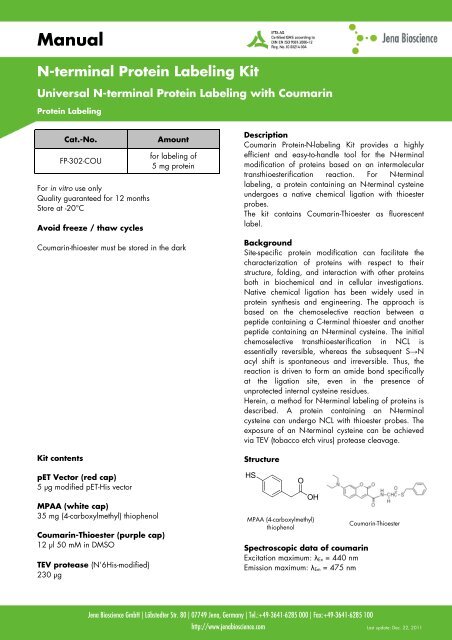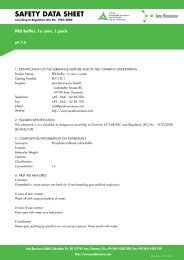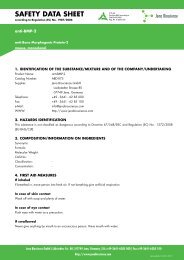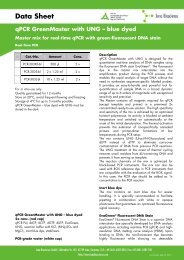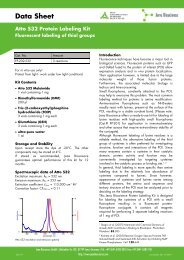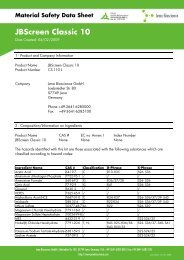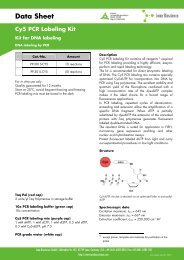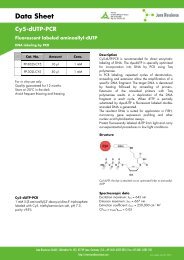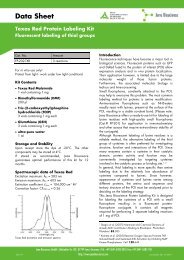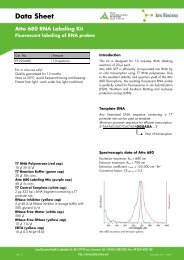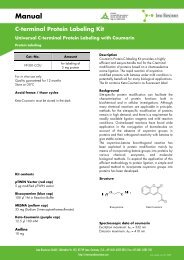N-terminal Protein Labeling Kit - Jena Bioscience
N-terminal Protein Labeling Kit - Jena Bioscience
N-terminal Protein Labeling Kit - Jena Bioscience
Create successful ePaper yourself
Turn your PDF publications into a flip-book with our unique Google optimized e-Paper software.
Manual<br />
N-<strong>terminal</strong> <strong>Protein</strong> <strong>Labeling</strong> <strong>Kit</strong><br />
Universal N-<strong>terminal</strong> <strong>Protein</strong> <strong>Labeling</strong> with Coumarin<br />
<strong>Protein</strong> <strong>Labeling</strong><br />
Cat.-No. Amount<br />
FP-302-COU<br />
For in vitro use only<br />
Quality guaranteed for 12 months<br />
Store at -20°C<br />
Avoid freeze / thaw cycles<br />
for labeling of<br />
5 mg protein<br />
Coumarin-thioester must be stored in the dark<br />
<strong>Kit</strong> contents<br />
pET Vector (red cap)<br />
5 µg modified pET-His vector<br />
MPAA (white cap)<br />
35 mg (4-carboxylmethyl) thiophenol<br />
Coumarin-Thioester (purple cap)<br />
12 µl 50 mM in DMSO<br />
TEV protease (N’6His-modified)<br />
230 µg<br />
Description<br />
Coumarin <strong>Protein</strong>-N-labeling <strong>Kit</strong> provides a highly<br />
efficient and easy-to-handle tool for the N-<strong>terminal</strong><br />
modification of proteins based on an intermolecular<br />
transthioesterification reaction. For N-<strong>terminal</strong><br />
labeling, a protein containing an N-<strong>terminal</strong> cysteine<br />
undergoes a native chemical ligation with thioester<br />
probes.<br />
The kit contains Coumarin-Thioester as fluorescent<br />
label.<br />
Background<br />
Site-specific protein modification can facilitate the<br />
characterization of proteins with respect to their<br />
structure, folding, and interaction with other proteins<br />
both in biochemical and in cellular investigations.<br />
Native chemical ligation has been widely used in<br />
protein synthesis and engineering. The approach is<br />
based on the chemoselective reaction between a<br />
peptide containing a C-<strong>terminal</strong> thioester and another<br />
peptide containing an N-<strong>terminal</strong> cysteine. The initial<br />
chemoselective transthioesterification in NCL is<br />
essentially reversible, whereas the subsequent S→N<br />
acyl shift is spontaneous and irreversible. Thus, the<br />
reaction is driven to form an amide bond specifically<br />
at the ligation site, even in the presence of<br />
unprotected internal cysteine residues.<br />
Herein, a method for N-<strong>terminal</strong> labeling of proteins is<br />
described. A protein containing an N-<strong>terminal</strong><br />
cysteine can undergo NCL with thioester probes. The<br />
exposure of an N-<strong>terminal</strong> cysteine can be achieved<br />
via TEV (tobacco etch virus) protease cleavage.<br />
Structure<br />
<strong>Jena</strong> <strong>Bioscience</strong> GmbH | Löbstedter Str. 80 | 07749 <strong>Jena</strong>, Germany | Tel.:+49-3641-6285 000 | Fax:+49-3641-6285 100<br />
HS<br />
O<br />
http://www.jenabioscience.com Last update: Dec. 22, 2011<br />
OH<br />
MPAA (4-carboxylmethyl)<br />
thiophenol<br />
Spectroscopic data of coumarin<br />
Excitation maximum: λEx = 440 nm<br />
Emission maximum: λEm = 475 nm<br />
Coumarin-Thioester
Manual<br />
N-<strong>terminal</strong> <strong>Protein</strong> <strong>Labeling</strong> <strong>Kit</strong><br />
Universal N-<strong>terminal</strong> <strong>Protein</strong> <strong>Labeling</strong> with Coumarin<br />
<strong>Protein</strong> <strong>Labeling</strong><br />
Procedure<br />
Preparation of proteins with N-<strong>terminal</strong> cysteine<br />
1. Clone target gene containing N-<strong>terminal</strong> tobacco<br />
etch virus (TEV) protease recognition site<br />
(ENLYFQC) into modified pET-His vector using<br />
NdeI and XhoI sites.<br />
2. Express protein (His-TEV-Cys-protein) in BL21(DE3)<br />
cells.<br />
3. Collect cells in 25 mL ice-cold Breaking Buffer<br />
freshly supplemented with 1 mM PMSF and 2<br />
mM β-mercaptoethanol. CRITICAL: PMSF and<br />
β-mercaptoenthanol should be added freshly.<br />
Don’t add any reducing substances.<br />
4. Lyse cells using a microfluidizer or ultrasonication.<br />
5. Centrifuge cell lysate at 35,000 rpm, 4°C for 30<br />
min.<br />
6. Filter supernatant through a 0.2 µm filter.<br />
7. Load cell lysate onto a Ni-NTA column<br />
equilibrated with Buffer A.<br />
8. Wash column with Buffer A and continue with<br />
2% Buffer B until absorbance reaches baseline.<br />
9. Elute column with a gradient of 2-100% Buffer<br />
B. Collect eluted fractions.<br />
10. Identify and collect fractions of interest by SDS-<br />
PAGE.<br />
11. Add tobacco etch virus (TEV) protease at 1:20<br />
molar ratio to the protein in the dialysis membrane<br />
tubing.<br />
12. Dialyze sample against Dialysis Buffer<br />
overnight.<br />
13. Centrifuge dialyzed solution at 8000 rpm for 10<br />
min. Collect supernatant.<br />
14. Add MgCl2 and imidazole to the supernatant to<br />
a final concentration of 5 mM and 10 mM,<br />
respectively.<br />
15. Load onto a Ni-NTA column equilibrated with<br />
Buffer A. Collect flow-through.<br />
16. Wash column with 2% Buffer B and collect flowthrough.<br />
17. Pool and concentrate protein from flow-through.<br />
18. Run a gel filtration on a Superdex column using<br />
Dialysis Buffer. CRITICAL: Prepare fresh<br />
solution, filter buffer through a 0.2 µm filter and<br />
degas on a vacuum-membrane pump by stirring<br />
for 0.5 h at room temperature.<br />
19. Identify and collect fractions of interest by SDS-<br />
PAGE. Concentrate protein and snap freeze in<br />
liquid nitrogen. Store protein at -80°C.<br />
<strong>Protein</strong> N-<strong>terminal</strong> <strong>Labeling</strong><br />
20. Incubate 50 µM N-Cys-protein with 500 µM<br />
Coumarin-Thioester in the presence of 200<br />
mM MPAA in Reaction Buffer on ice<br />
overnight. The reaction is monitored by ESI-MS.<br />
21. Remove excess dye using a desalting column preequilibrated<br />
in Dialysis Buffer.<br />
<strong>Jena</strong> <strong>Bioscience</strong> GmbH | Löbstedter Str. 80 | 07749 <strong>Jena</strong>, Germany | Tel.:+49-3641-6285 000 | Fax:+49-3641-6285 100<br />
http://www.jenabioscience.com Last update: Dec. 22, 2011
Manual<br />
N-<strong>terminal</strong> <strong>Protein</strong> <strong>Labeling</strong> <strong>Kit</strong><br />
Universal N-<strong>terminal</strong> <strong>Protein</strong> <strong>Labeling</strong> with Coumarin<br />
<strong>Protein</strong> <strong>Labeling</strong><br />
To be provided<br />
Breaking Buffer<br />
25 mM NaH2PO4 pH 7.5, 0.5 M NaCl<br />
PMSF<br />
β-mercaptoethanol<br />
Buffer A<br />
50 mM NaH2PO4 pH 8.0, 0.3 M NaCl,<br />
2 mM β-mercaptoethanol<br />
Buffer B<br />
50 mM NaH2PO4 pH 8.0, 0.3 M NaCl,<br />
2 mM β-mercaptoethanol, 0.5 M imidazole<br />
Reaction Buffer<br />
30 mM NaH2PO4 pH 7.5, 50 mM NaCl<br />
Dialysis Buffer<br />
30 mM NaH2PO4 pH 7.5, 50 mM NaCl, 2 mM DTE<br />
<strong>Jena</strong> <strong>Bioscience</strong> GmbH | Löbstedter Str. 80 | 07749 <strong>Jena</strong>, Germany | Tel.:+49-3641-6285 000 | Fax:+49-3641-6285 100<br />
http://www.jenabioscience.com Last update: Dec. 22, 2011
Manual<br />
N-<strong>terminal</strong> <strong>Protein</strong> <strong>Labeling</strong> <strong>Kit</strong><br />
Universal N-<strong>terminal</strong> <strong>Protein</strong> <strong>Labeling</strong> with Coumarin<br />
<strong>Protein</strong> <strong>Labeling</strong><br />
Selected References<br />
Yi, L. et al. (2010) A Highly Efficient Strategy for Modification of<br />
<strong>Protein</strong>s at the C Terminus. Angewandte Chemie Int. Ed. 49:9417.<br />
Yi, L. et al. (2011) One-Pot Dual-<strong>Labeling</strong> of a <strong>Protein</strong> via Two<br />
Chemoselective Reactions. Angewandte Chemie Int. Ed. 50: 8287.<br />
<strong>Jena</strong> <strong>Bioscience</strong> GmbH | Löbstedter Str. 80 | 07749 <strong>Jena</strong>, Germany | Tel.:+49-3641-6285 000 | Fax:+49-3641-6285 100<br />
http://www.jenabioscience.com Last update: Dec. 22, 2011


